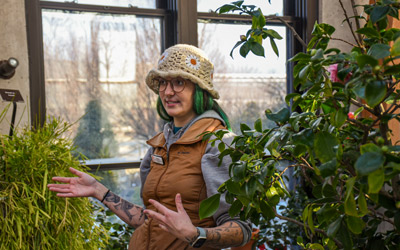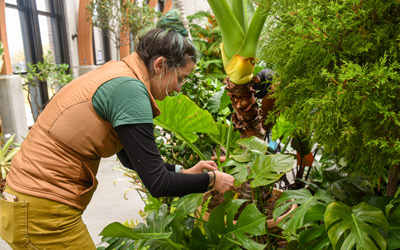By Liz Nye, New England Botanic Garden Staff
January 2023
In its natural habitat, the vigorously growing banana plant can unfurl its large leaves in a matter of days. Each leaf, long and fan-like when it finally meets the tropical sun, emerges from a central stem as a tightly rolled cylinder known, for its look, as a cigar leaf. But inside the Limonaia, one of the Garden’s two glass conservatories, banana plants on display often take their time stretching new cigar leaves open. 
“The more we can replicate the environment the plant lives in, the more likely it will be to unfurl that leaf,” says Brooke Harris, a member of the Garden’s “Conservatory Crew.” She points to one banana plant with a leaf just starting to widen out. The leaf looks less like a cigar now and more like a sheet of paper rolled into an imaginary telescope.
The Garden’s small collection of banana plants is part of a tropical and subtropical plant collection numbering in the hundreds. The collection exhibits species found on every continent, except Antarctica. It includes plants on the IUCN Red List for threatened species, as well as plants that are so old, phylogenetically speaking, that their genetic makeup has remained unchanged since the time of the dinosaurs.
If you’ve ever killed a houseplant, it may come as no surprise that creating and maintaining an indoor oasis suitable for so many growing things isn’t easy. So how in the world does the Garden’s Horticulture Team keep its diverse collection of conservatory plants happy inside the Limonaia and the Orangerie? Get ready. We’re taking you on a conservatory deep dive to find out.
Water, Water Everywhere 
When Brooke starts her day at the Garden, she heads straight to the Limonaia to check on the temperature. It’s important to the plants here that the temperature stays between 55 and 65 degrees Fahrenheit. Humidity is important, too, and in winter, it’s often a challenge to keep this up. That’s where watering comes in.
“This morning, the humidity in the Limonaia was at 37 percent,” Brooke says. “I just did a quick shower of the floor, walked around and showered some of the plants, and by the time I was done, we were up to 66 percent.”
The same, all-over watering happens daily in the Orangerie, too. Unlike the Limonaia, the Orangerie maintains higher heat and humidity. For this reason, plants here tend to grow faster than plants in the Limonaia.
When it comes to watering the plants themselves, Brooke often assesses how much each individual needs by the look of the soil. Dark soil tends to indicate moist, watered plants. A fluffy, loose, and lighter appearance indicates soil that is drying out. Brooke’s organized the Limonaia in such a way that plants requiring less water like agaves line the outside of the space. Plants that need more water like palms, ferns, and bromeliads, are clustered in aesthetically pleasing groups toward the center.
To Groom or to Prune?
While walking through the Limonaia, Brooke describes the daily upkeep that helps plants stay healthy and vibrant looking. As if on cue, a spent flower from a nearby camellia drops to the floor. Camellias bloom profusely throughout the winter. Every morning, the team scans plants throughout the conservatories for browning or dead leaves that need to be plucked away. Once a week or so, they’ll identify plants that need pruning.
Massive vines like the giant Dutchman’s pipe, also known as pelican flower (Aristolochia gigantea), and the Jade Vine (Strongylodon macrobotrys), both located in the Orangerie, require a significant annual cut back to keep them from taking over the building’s trusses. To access these vines, the team hops on a scissor lift and has at it. While the cut back may seem dramatic to Garden visitors on trimming day, no one need worry. In the hot, humid Orangerie, the vines flourish after a haircut. In a few months, they look again as twining and lush as ever.
Good Bugs, Bad Bugs
 When you create warm, humid indoor environments, tropical and subtropical plants thrive. The problem is that insect pests do, too. Since starting at the Garden roughly a year and half ago, Brooke has been deepening her knowledge of how to manage pests like aphids and mealybugs with other insect species. These beneficial bugs, also known as biological control agents, are often predatory species that feed on pests without damaging plants. They offer a natural alternative for pest management and are part of the Garden’s integrated pest management strategy.
When you create warm, humid indoor environments, tropical and subtropical plants thrive. The problem is that insect pests do, too. Since starting at the Garden roughly a year and half ago, Brooke has been deepening her knowledge of how to manage pests like aphids and mealybugs with other insect species. These beneficial bugs, also known as biological control agents, are often predatory species that feed on pests without damaging plants. They offer a natural alternative for pest management and are part of the Garden’s integrated pest management strategy.
“At first, my fear was that we would be releasing these beneficial bugs and they would just die without us really knowing if they did anything,” Brooke says. Many beneficials that she and the team apply to plants are microscopic. But increasingly, Brooke sees evidence that these beneficials are doing their part: aphids parasitized on a hibiscus in the Orangerie; assassin bugs (Zelus renardii) flitting around among the foliage of the Jade vine. “There’s now a community of beneficial bugs that we’re building up in these spaces,” Brooke says. So, if you see a bug on your visit, leave the bug. It may be working for the Garden.
Despite successes with biological controls, managing pests in the conservatories requires constant vigilance and scouting. Suppressing one pest often creates opportunities for another to flourish. Mealybugs, tiny, oval-shaped insects identifiable by the white, cotton-looking wax they coat themselves with, can be especially devasting. When an infestation requires tougher treatment than biological controls can offer, the team applies systemic insecticides and may also remove plants from display, isolating them until the pest problem is under control.
Plants On the Move
Some of the Garden’s oldest and largest conservatory plants are planted directly into the floor, but most are not. They grow in pots of every size. Several grow in Versailles boxes, large containers designed for citrus trees. Versailles boxes have openings that allow the team to access a tree’s root ball and trim it to control the plant’s above-soil growth.
The number of conservatory plants the Garden displays in pots makes it unique among botanic gardens. During summer months, the Garden team moves almost all the plants outdoors. The collection takes up residence in the Winter Garden, the terrace of the Garden of Inspiration, The Court: A Garden Within Reach, and the Cottage Garden.
Before plants move back indoors, “The Conservatory Crew” designs new plant layouts within each conservatory space. They consider not only what makes the most sense for the plants and their care, but also what will be most appealing to visitors. This year, the Orangerie’s layout, designed by conservatory gardener Greg Farrington, included a winding path. Nooks with tables and chairs invite visitors to stay a while.
In winter, soaking up the sun in the conservatories is one of many ways to enjoy the season at the Garden. While the plants spend their day photosynthesizing, visitors may find food for the soul. And as the sun tracks overhead, guests may even notice that the plants respond by making subtly perceptible moves toward its light.
“I wish I could set a time lapse camera on these plants every day,” Brooke says, looking around the Limonaia. “Just spending time in here and seeing them grow is such a cool experience.”
Liz Nye is the Public Relations Manager at New England Botanic Garden. She holds a master’s degree in science writing from Johns Hopkins University and enjoys learning about and writing about all things plants.
